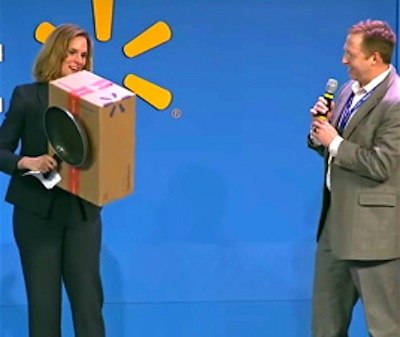Walmart reviewing box sizes for online shipments, reducing millions of pounds of cardboard
by April 19, 2016 5:17 pm 1,674 views

Walmart.com said it’s paying closer attention to the way boxes are packed for its online delivery service. The changes could reduce millions of cubic feet of cardboard use, and it’s thanks to unsolicited comments from customers asking the retailer to reduce waste.
Justen Traweek, vice president of operations and fulfillment for Walmart, recently said the retailer was using just 12 box options for its e-commerce deliveries of online orders. Traweek said an overwhelming majority of customers sent unsolicited comments about the sizes of boxes used in online deliveries from Walmart.com.
“Over and over again, our customers expressed a desire for us to reduce our packaging, so we assembled a team to focus on this,” he said during the retailer’s recent Sustainability Showcase.
He said they began with a small customer insights team in San Bruno, Calif., and then brought in some logistics team members to the fulfillment center. He said they worked across several different business units to gain the best possible insight and then began testing smaller boxes with less air than those previously used.
The retailer has expanded packing options to 27 various box sizes and through extensive testing it developed a way to improve cardboard utilization by more than 30% without sacrificing product protection. He said the company settled on 27 box sizes after testing the new sizes on more than 10,000 orders. The company piloted the program over the past year.

For every three truckloads packed under the old system, the same freight can now fit in two truckloads, he said.
“If scaled over our entire e-commerce operation in the U.S., this effort has the potential to reduce cardboard box consumption by 7.2 million cubic feet annually, roughly enough to fill 82 Olympic-size swimming pools. It also translates into the ability to pack more products into the tractor-trailers we put on the road,” Traweek added.
He said the company will soon implement the program at a second e-commerce fulfillment center and, eventually, across the organization. But Traweek insists the key to success lies in the retailer’s ability to customize the program to the needs of every facility.
“This program will have to be continuously monitored and adjusted to meet changing needs. What is achievable at one facility with an assortment of 27 boxes may require an assortment of 40 boxes at another. And we’re up to that challenge,” he said.
Sustainability is synonymous with good business according to Wal-Mart Stores CEO Doug McMillon and his top executive team. U.S. CEO Greg Foran said that Walmart is always looking for ways to lower costs, but it has to be done the right way. He said working toward the company’s sustainability goals is a way to achieve that, doing what is right for the environment and running a better company.
“Our customers have high expectations, they expect us to deliver them value, they expect us to deliver them quality and they also expect us to do it in a way that is good for the environment,” said Neil Ashe, CEO of Walmart Global eCommerce and Technology.
Within its own supply chain involving apparel vendors, a replenish team member said during the recent sustainability meeting that case packs used in the apparel division were too small which created inefficiencies in the supply chain because smaller packages require added manpower and they create more corrugate in the process. Walmart said they began with one supplier and then looked across the industry and found that 70% of the cases shipped were too small.
Walmart said they created a tool that was put in the hands of buyers that helped to better determine the right size of packaging needed for optimum supply chain efficiencies. By increasing the pack sizes used in apparel shipments between the supplier and retailer they were able to remove 8 million packs from the supply chain from the fashion network. With the 8 million boxes there was a 6 million pound reduction in corrugate, Walmart said.
